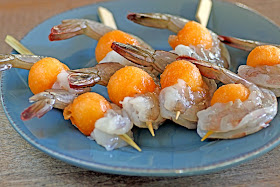I'm not sure how I decided on Pupusas, a traditional Salvadoran dish made of thick, hand-made corn tortilla (made using masa de maiz), and usually filled with cheese, cooked pork (chicharrón), and/or refried beans. They are similar to South American arepas, and Mexican gorditas. It's challenging making something you've never even heard of, but they were unique, easy, and tasty, and I was able to get some use out of our tortilla press.
I read a few blogs and watched some videos on making pupusas, but saw only one chef using a tortilla press. The dough is usually shaped, filled, closed back up, and flattened in the palm of your hand, but I liked the idea of a more uniform, thinner tortilla surrounding the filling. The video demonstration that inspired me, by Chef Sergio Remolina of the Culinary Institute of America, can be found here.
For my filling, I used crispy pork belly (Chef Remolina used pork rind), Lila beans from Rancho Gordo's Xoxoc Project Sampler, and queso añejo. I cooked the pupusas in about a 1/2 inch of canola oil, wrapped them in foil, and reheated them at the park, made to order, in a dry, nonstick skillet. John whipped up a little chipotle crema for dipping, and we were good to go! These do need to be served hot, but I love sitting in the park, with my little portable burner fired up, and cooking on the fly.
My dessert was not quite as successful, but the flavors were perfect for the theme. I've been MIA in the Daring Cooks' and Bakers' Challenges since I hosted the Gumbo Challenge, and it was time to get back into the game.
Jana of Cherry Tea Cakes was our July Daring Bakers’ host. She challenged us to make Fresh Fraisiers, inspired by recipes written by Elisabeth M. Prueitt and Chad Robertson in the beautiful cookbook, Tartine.
 Fraisiers are light, moist, chiffon layered cakes, split and filled with sliced strawberries and pastry cream, then topped with a thin sheet of almond paste.
Fraisiers are light, moist, chiffon layered cakes, split and filled with sliced strawberries and pastry cream, then topped with a thin sheet of almond paste.I had the not-so brilliant idea of creating a Tres Leches Fraisier Cake, incorporating our Latin American theme and flavors. Tres leches cake, or pastel tres leches (Spanish, "three milk cake"), is a sponge cake soaked in three kinds of milk: evaporated milk, condensed milk, and heavy cream, and topped with whipped cream. It is very popular in Nicaragua, Mexico, Cuba, Puerto Rico, and Guatemala.
Because I used a deep, 6" springform pan, the cake didn't cook all the way in the middle (although it appeared to be done and passed the clean toothpick test). My next problem occurred when the pastry cream didn't firm up with the gelatin. After cutting the cake into two layers, I ended up cutting the uncooked portion out of the middle. I filled the hole with chopped mango and added the pastry cream between the layers, carefully placing a decorative kiwi and mango design around the outside edge to show through between the layers. After the required time in the refrigerator, I lifted off the springform pan, and cussed under my breath as a good portion of the pastry cream oozed out everywhere, along with my pretty design of fruit. Oh well, live and learn. Of course, in hindsight, I should have I followed the recipe for the Mango Tres Leches Cake for our Concert dessert, and prepared a second cake according to the Daring Bakers' Fraisier Cake recipe for the DB Challenge, but I was trying to be creative and combine two cakes into one.
But, the flavors were wonderful - coconut, brandy, mango puree, vanilla pastry cream, and fresh kiwis, mango and blueberries. It just didn't look like a Tres Leches Cake OR a Fraisier.
The recipe for Mango Tres Leches Cake can be found here, and the recipe for the Daring Bakers' Fresh Fraisier can be found here. I need to give this one another go, because many of the cakes turned out by the talented Daring Bakers are simply gorgeous.
 |
| Sunset, at Spreckels Park |






 , is organized by similar chapters: Sticks, Picks, and with Fingers; Dressed, Not Naked; Bowls and Spoons; On a Raft; Knife and Fork; and Something Sweet. In old diner lingo, if something came "on a raft," it meant that the food was served up on toast. Our group stretched that concept to include buns, naan bread, baguette slices, graham crackers, jicama slices, endive and lettuce leaves, tortilla chips, tart shells, nut crusts, hollowed out orange halves, and melon slices.
, is organized by similar chapters: Sticks, Picks, and with Fingers; Dressed, Not Naked; Bowls and Spoons; On a Raft; Knife and Fork; and Something Sweet. In old diner lingo, if something came "on a raft," it meant that the food was served up on toast. Our group stretched that concept to include buns, naan bread, baguette slices, graham crackers, jicama slices, endive and lettuce leaves, tortilla chips, tart shells, nut crusts, hollowed out orange halves, and melon slices.
































